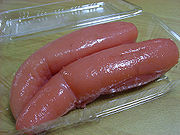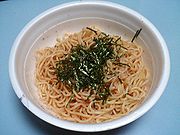
Tarako (food)
Encyclopedia


Japanese cuisine
Japanese cuisine has developed over the centuries as a result of many political and social changes throughout Japan. The cuisine eventually changed with the advent of the Medieval age which ushered in a shedding of elitism with the age of shogun rule...
, is a salted roe
Roe
Roe or hard roe is the fully ripe internal egg masses in the ovaries, or the released external egg masses of fish and certain marine animals, such as shrimp, scallop and sea urchins...
food, usually made from Alaska pollock
Alaska pollock
Alaska pollock or walleye pollock is a North Pacific species of the cod family Gadidae. While related to the common Atlantic pollock species of the same family, the Alaska pollock is not a member of the same Pollachius genus.The Norwegian pollock , a rare fish of Norwegian waters, may actually be...
, although actually means cod
Cod
Cod is the common name for genus Gadus, belonging to the family Gadidae, and is also used in the common name for various other fishes. Cod is a popular food with a mild flavor, low fat content and a dense, flaky white flesh. Cod livers are processed to make cod liver oil, an important source of...
in Japanese
Japanese language
is a language spoken by over 130 million people in Japan and in Japanese emigrant communities. It is a member of the Japonic language family, which has a number of proposed relationships with other languages, none of which has gained wide acceptance among historical linguists .Japanese is an...
.
Tarako is served in a number of ways:
- Plain (usually for breakfast)
- As a filling for onigiriOnigiri, also known as or rice ball, is a Japanese food made from white rice formed into triangular or oval shapes and often wrapped in nori . Traditionally, an onigiri is filled with pickled ume , salted salmon, katsuobushi, kombu, tarako, or any other salty or sour ingredient as a natural preservative...
- As a pastaPastaPasta is a staple food of traditional Italian cuisine, now of worldwide renown. It takes the form of unleavened dough, made in Italy, mostly of durum wheat , water and sometimes eggs. Pasta comes in a variety of different shapes that serve for both decoration and to act as a carrier for the...
sauce (usually with noriNoriis the Japanese name for various edible seaweed species of the red alga Porphyra including most notably P. yezoensis and P. tenera, sometimes called laver. Finished products are made by a shredding and rack-drying process that resembles papermaking...
)
Traditionally, tarako was dyed bright red, but recent concerns about the safety of food coloring
Food coloring
Food coloring is a substance, liquid or powder, that is added to food or drink to change its color. Food coloring is used both in commercial food production and in domestic cooking...
have all but eliminated that custom. In Kyūshū
Kyushu
is the third largest island of Japan and most southwesterly of its four main islands. Its alternate ancient names include , , and . The historical regional name is referred to Kyushu and its surrounding islands....
, tarako is commonly served with red chili pepper
Chili pepper
Chili pepper is the fruit of plants from the genus Capsicum, members of the nightshade family, Solanaceae. The term in British English and in Australia, New Zealand, India, Malaysia and other Asian countries is just chilli without pepper.Chili peppers originated in the Americas...
flakes, possibly due to that region's historic ties with Korean culture
Culture of Korea
The current political separation of North and South Korea has resulted in divergence in modern Korean cultures; nevertheless, the traditional culture of Korea is historically shared by both states.-Dance:...
.

